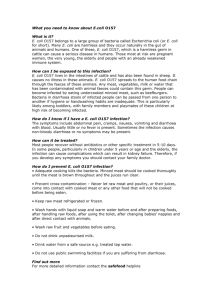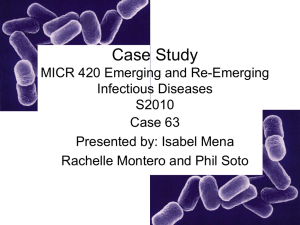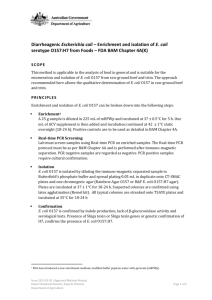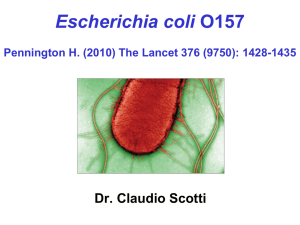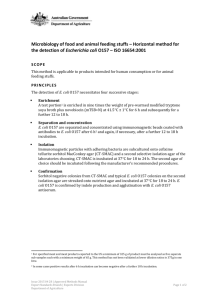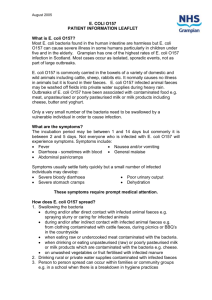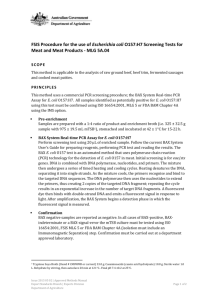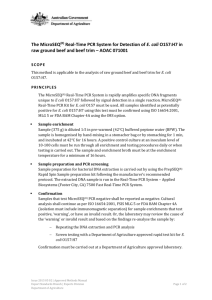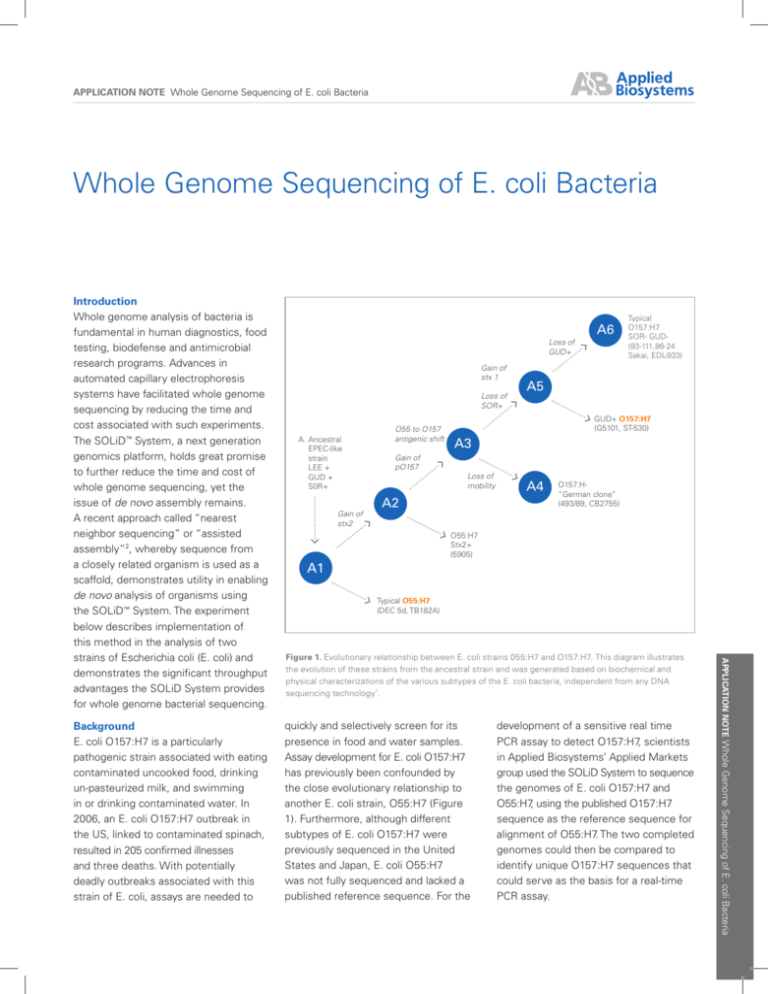
APPLICATION NOTE Whole Genome Sequencing of E. coli Bacteria
Whole Genome Sequencing of E. coli Bacteria
Background
E. coli O157:H7 is a particularly
pathogenic strain associated with eating
contaminated uncooked food, drinking
un-pasteurized milk, and swimming
in or drinking contaminated water. In
2006, an E. coli O157:H7 outbreak in
the US, linked to contaminated spinach,
resulted in 205 confirmed illnesses
and three deaths. With potentially
deadly outbreaks associated with this
strain of E. coli, assays are needed to
A6
Loss of
GUD+
Gain of
stx 1
Loss of
SOR+
A. Ancestral
EPEC-like
strain
LEE +
GUD +
S0R+
Gain of
stx2
O55 to O157
antigenic shift
Typical
O157:H7
SOR- GUD(93-111,86-24
Sakai, EDL-933)
A5
GUD+ O157:H7
(G5101, ST-530)
A3
Gain of
pO157
Loss of
mobility
A2
A4
O157:H“German clone”
(493/89, CB2755)
O55:H7
Stx2+
(5905)
A1
Typical O55:H7
(DEC 5d, TB182A)
Figure 1. Evolutionary relationship between E. coli strains 055:H7 and O157:H7. This diagram illustrates
the evolution of these strains from the ancestral strain and was generated based on biochemical and
physical characterizations of the various subtypes of the E. coli bacteria, independent from any DNA
sequencing technology1.
quickly and selectively screen for its
presence in food and water samples.
Assay development for E. coli O157:H7
has previously been confounded by
the close evolutionary relationship to
another E. coli strain, O55:H7 (Figure
1). Furthermore, although different
subtypes of E. coli O157:H7 were
previously sequenced in the United
States and Japan, E. coli O55:H7
was not fully sequenced and lacked a
published reference sequence. For the
development of a sensitive real time
PCR assay to detect O157:H7, scientists
in Applied Biosystems’ Applied Markets
group used the SOLiD System to sequence
the genomes of E. coli O157:H7 and
O55:H7, using the published O157:H7
sequence as the reference sequence for
alignment of O55:H7. The two completed
genomes could then be compared to
identify unique O157:H7 sequences that
could serve as the basis for a real-time
PCR assay.
APPLICATION NOTE Whole Genome Sequencing of E. coli Bacteria
Introduction
Whole genome analysis of bacteria is
fundamental in human diagnostics, food
testing, biodefense and antimicrobial
research programs. Advances in
automated capillary electrophoresis
systems have facilitated whole genome
sequencing by reducing the time and
cost associated with such experiments.
The SOLiD™ System, a next generation
genomics platform, holds great promise
to further reduce the time and cost of
whole genome sequencing, yet the
issue of de novo assembly remains.
A recent approach called “nearest
neighbor sequencing” or “assisted
assembly”2, whereby sequence from
a closely related organism is used as a
scaffold, demonstrates utility in enabling
de novo analysis of organisms using
the SOLiD™ System. The experiment
below describes implementation of
this method in the analysis of two
strains of Escherichia coli (E. coli) and
demonstrates the significant throughput
advantages the SOLiD System provides
for whole genome bacterial sequencing.
Methods
Two mate-paired libraries, one for E. coli
O157:H7 and one for E. coli O55:H7,
were constructed with ~2.5kb insert
sizes and emulsion PCR was carried
out using standard SOLiD protocols.
Both the O157:H7 and O55:H7 libraries
were deposited in duplicate onto a
single slide and sequenced in a single
run using the SOLiD Analyzer. Unique
reads resulting from the O157:H7
library were aligned to the reference
sequence (NCBI: NC_002655 and
GI16445223) and a consensus assembly
was generated using the SOLiD Analysis
Tools. Next, the unique reads from
the O55:H7 library were aligned to the
reference sequence for O157:H7 and a
second consensus generated. The two
consensus sequences were compared
and any regions of the O157:H7 that
were not seen in O55:H7 were identified
as unique sequences and potential
targets for real-time PCR assays.
Results
Unique reads from the two libraries
aligned with relatively uniform coverage
across the genome (Figure 3). The
accuracy of the SOLiD System has
previously been demonstrated to be
99.999% at 15X coverage. In this
experiment, an average coverage of
20X was achieved for both libraries
indicating that the library constructions
were very successful. The specific
E. coli O157:H7 isolate sequenced in
this experiment matched 98% of the
reference sequence. The closely related
E. coli O55:H7 matched ~92% of the
reference sequence.
A comparison of the genomes
sequenced by the SOLiD System is
shown in Figure 4. As expected, E. coli
O55:H7 reads did not cover parts of the
O157:H7 EDL-933 reference sequence.
These regions were well covered
by the O157:H7 reads and provide
evidence that these gaps represent true
differences in sequence content rather
than lack of coverage of those regions.
SOLiD™ Sequencing of Two Strains of E. Coli (055:H7 and O157:H7)
O55:H7
O157:H7
Mate-paired library
Mate-paired library
Sequencing on SOLiD System
O55
O55
O157
O157
Aligned reads to O157:H7
Reference
Aligned reads to O157:H7
Reference
Generate O55:H7 SOLiD
Consensus
Generate O157:H7 SOLiD
Consensus
Compare consensus sequences and identify regions unique to O157:H7
Figure 2. Workflow for 055:H7 “nearest neighbor” sequencing
The detection of these differences
between the two genomes holds
great promise for the development of
detection assays for the dangerous
E. coli O157:H7 strain.
Additionally, Figure 4 illustrates the ability
of the SOLiD System to obtain uniform
coverage in genomic areas of variable GC
content. The GC content of the reference
sequence is shown in the second circle
of the figure and the data indicates there
was no impact of high GC content on
coverage achieved in this experiment.
Conclusion
The complete 5.5 MB E. coli O55:H7
genome was successfully sequenced
on the SOLiD System using a closely
related organism, E. coli O157:H7, as
E. coli 055:H7 depth of coverage across the reference
160
140
140
120
120
Depth of coverage
Depth of coverage
E. coli 0157:H7 depth of coverage across the reference
160
100
80
100
80
60
60
40
40
20
20
0
0
0
1
2
3
Reference position
4
5
x1e+5
0
1
2
3
Reference position
4
5
x1e+6
Figure 3. Coverage Map of E. Coli O157:H7 and E. Coli O55:H7 from SOLiD ™ Experimental Tracking Software.
the reference. This method of “nearest
neighbor” or “assisted assembly”
sequencing holds great promise in
enabling de novo analyses using the
SOLiD System. Comparison of the
consensus sequences for both E. coli
O157:H7 and E. coli O55:H7 identified
regions unique to the O157:H7 strain
which are potential targets for a
highly specific screening assay for the
pathogenic strain. The SOLiD System’s
ultra high throughput and flexible bead
deposition formats allowed researchers
to sequence both E. coli genomes,
in duplicate, on a single slide. These
attributes enable the SOLID System
to significantly reduce the time and
the cost to sequence any bacterium.
Multiple whole genome bacterial
sequencing projects can now be
completed in less than two weeks
instead of months.
References
1
Wick, L., Journal of Bacteriology
17:1547-1549 (2007).
2
Green P., Genome Res. 187:1783-1791
(2005).
EDL933
Reference
0157:H7
Gene Track
fwd and rev
GC content
Per 1000
O157:H7 SOLiD
coverage of ref
O55:H7 SOLiD
coverage of ref
Unique region
Figure 4. O157:H7 and O55:H7 Genome Comparison — Gaps seen only in O55:H7 (orange arrow) indicate
that sequence is missing in this strain but present in O157:H7. This unique region in the O157:H7 genome
is suitable for further assay development.
For Research Use Only. Not for use in diagnostic procedures.
© 2008 Applied Biosystems. All rights reserved. Applied Biosystems is a registered trademarks and AB (Design), Applera, and SOLiD are trademarks of Applera Corporation in the
US and/or in certain other countries. All other trademarks are the sole property of their respective owners.
Printed in the USA, 02/2008, Publication 139AP09-01
Headquarters
850 Lincoln Centre Drive | Foster City, CA 94404 USA
Phone 650.638.5800 | Toll Free 800.345.5224
www.appliedbiosystems.com
International Sales
For our office locations please call the division
headquarters or refer to our Web site at
www.appliedbiosystems.com/about/offices.cfm

